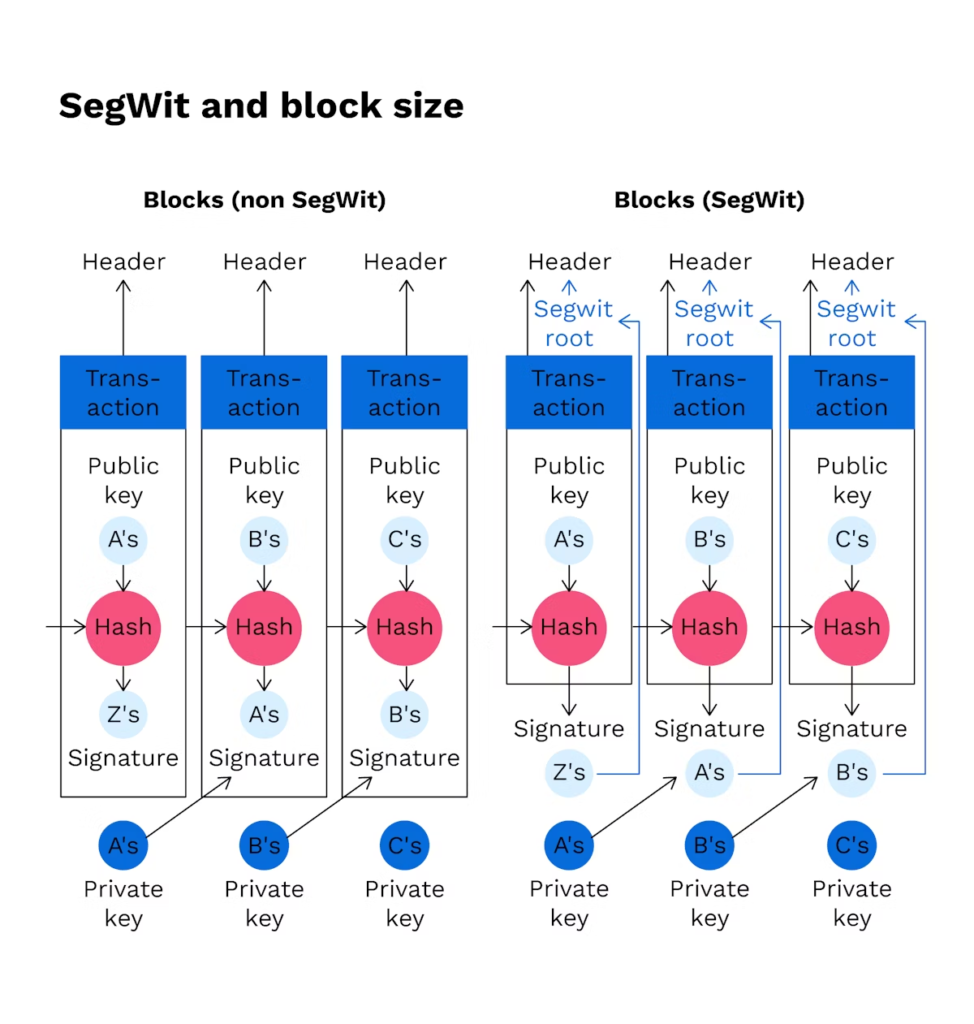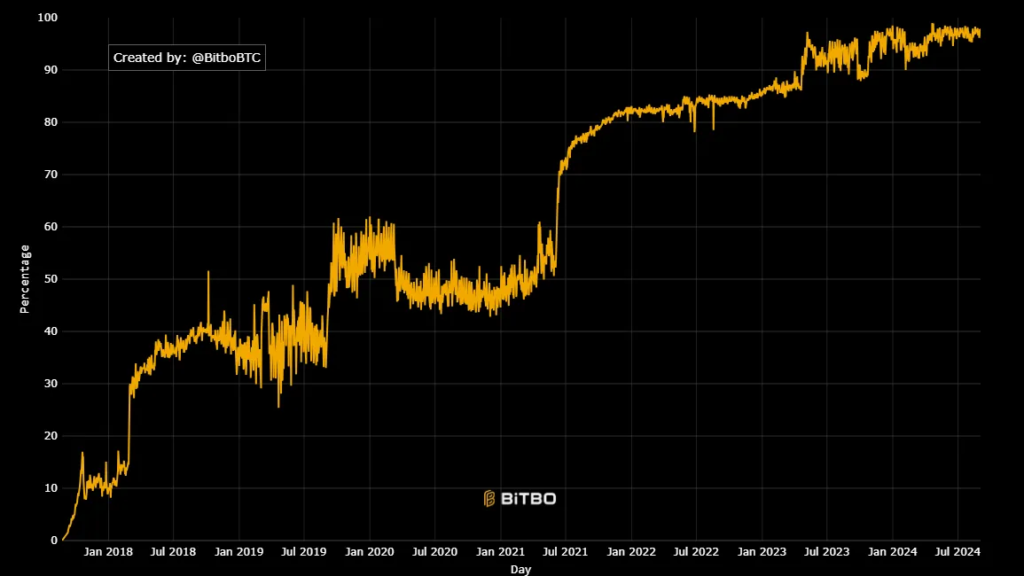Since its launch in 2009, Bitcoin has showcased blockchain technology to the world, providing a blueprint for a new kind of currency — decentralized, digital, and independent of traditional banking systems. It is the first cryptocurrency and a widely recognized store of value and medium of exchange, with a market capitalization in the hundreds of billions.
But, as Bitcoin grew more popular, it ran into a bit of a snag. More users meant more transactions. And with that, Bitcoin’s original architecture—with its 1-megabyte block size—began to reveal its limits. This bottleneck slowed transaction processing times and drove up transaction fees, signaling a clear need for Bitcoin scalability solutions.
So, you know what happened next? Segregated Witness or SegWit.
Rather than increasing the size of each block, SegWit changes how data is stored, allowing for more transactions within a single block.
Bitcoin SegWit upgrade is an important step that improves Bitcoin scalability solutions by optimizing data storage. It allows more transactions per block, reduces fees, and addresses transaction malleability issues. On average, this upgrade has enabled more efficient use of blockchain space and laid the groundwork for second-layer solutions like the Lightning Network.
This article will walk through the mechanics behind the Bitcoin SegWit upgrade, its rollout, and the broader effects these changes have had on the Bitcoin network. Ready? Let’s dive in.
The Scalability Problem Before SegWit
The vision of Bitcoin’s creator, Satoshi Nakamoto equipped Bitcoin with a 1 megabyte (MB) block size limit, a cautious measure against potential spam attacks. This safeguard was designed to ensure that nodes could efficiently manage both the processing and storage demands.
Back then, Bitcoin was more of an experiment, with a small, tight-knit community of enthusiasts. So, that 1 MB limit? It was more than enough.
However, as Bitcoin edged into the mainstream spotlight, the limitations tethered to the 1 MB block size threshold became glaringly evident. Given that each block in the Bitcoin blockchain was capped at housing only a select number of transactions—ranging between 2,000 and 3,000—the system’s capacity was quickly outstripped as adoption swelled.
The ramifications of this congestion were profound. A ballooning backlog of unconfirmed transactions precipitated delays and spurred an increase in transaction fees.
Under normal circumstances, the Bitcoin network aims for a transaction confirmation time of roughly 10 minutes. However, during episodes of heightened network activity, particularly amidst Bitcoin bull runs, confirmation times could elongate to several hours or even days. These scalability challenges were not only inconvenient but underlined deeper systemic vulnerabilities.
One such vulnerability was transaction malleability. This flaw permitted the alteration of certain transaction elements—viz, the digital signature—without affecting the core transaction content. Though this did not render the transaction void, it altered its unique transaction ID. Of course, it is a big challenge for platforms relying on tracking transactions by their IDs, such as exchanges and wallet services.
And let’s not forget, this issue also put a wrench in the development of second-layer solutions like the Lightning Network, which relies on unchangeable transaction IDs.
For users, these scalability challenges translated into practical inconveniences.
Remember back in late 2017 when transaction fees shot up to nearly $55? Such exorbitant fees rendered Bitcoin impractical for small-scale transactions (a striking deviation from its intended role as a universally accessible digital currency).
Addressing Scalability Through Innovation: The Bitcoin SegWit Upgrade
In the quest for Bitcoin scalability solutions, the community proposed and implemented the Bitcoin SegWit upgrade. By this, the target was to solve the pressing issues of network congestion, high fees, and transaction malleability by optimizing the way data is stored within blocks.
SegWit, short for Segregated Witness, emerged not only as a technique to increase the number of transactions within each block but also as a foundational improvement, setting the stage for further innovations and the adoption of second-layer solutions.
Incorporating the Bitcoin SegWit upgrade and exploring Bitcoin scalability solutions are a testament to the adaptability and forward momentum of the Bitcoin network.
What Is Segregated Witness (SegWit)?
Segregated Witness (SegWit), is an upgrade to the Bitcoin protocol that was implemented in August 2017. It modifies how transaction data is stored by separating the digital signature (witness data) from the main transaction data.
This innovative proposal was first introduced by Pieter Wuille, a respected Bitcoin Core developer, at the Scaling Bitcoin conference in December 2015. Cool, right?
The Core Functionality of SegWit
At its essence, SegWit fundamentally altered the storage method of transaction data—
- Separation of Data: In standard Bitcoin transactions, each input includes witness data containing cryptographic signatures necessary for verification. Vulnerable to alteration by third parties before a transaction’s confirmation, this witness data led directly to the transaction malleability issue.
SegWit addressed this by segregating these signatures from transaction data, which meant rendering transaction IDs immutable once issued by the sender.
- Enhancing Transaction Capacity: Removing the witness data from the main transaction block, enabled more transactions to be packed into each block, believe it or not, starkly improving the network’s scalability.
Importantly, this was achieved without the need to increase the block size—a decision avoiding a hard fork that could potentially fracture the network. Smart move, don’t you think?
How SegWit Works
Traditional, or “legacy,” transactions bundle inputs, outputs, and witness data together. Given that witness data often constitutes a substantial portion of a transaction’s size—particularly in transactions requiring multiple signatures—the new approach was far from efficient, thanks to the Bitcoin segwit upgrade.
So, how does SegWit make things better?

- Data Separation: SegWit introduces an additional structure, often referred to as the “extended block,” allocated specifically for witness data. Meanwhile, the core transaction information—detailing who is sending Bitcoin to whom—remains within the original block.
- Streamlined Blocks: This restructuring means more transactions can be squeezed into the standard 1 MB block size. You’re probably wondering, “How?” Well, witness data is treated differently under SegWit’s “block weight” concept, a new calculation metric that allows for more efficient use of space within each block by applying a discount to the witness data.
- Immutable Transaction IDs: By relocating witness data outside of the transaction’s main body, SegWit ensures the transaction ID (or txid) remains unaffected by alterations to this data, cementing its immutability.
- Foundation for innovation: Thanks to the removal of malleability concerns, advancements like the Lightning Network have a reliable groundwork to build upon, propelling the Bitcoin ecosystem forward with enhanced security and the potential for exponential scaling.
The Smooth Transition Powered by SegWit
Implementing such a fundamental change without disrupting the Bitcoin network was no small feat. That’s where the strategic deployment of SegWit as a “soft fork” played a big role.
SegWit’s design ensures that nodes running on older versions of Bitcoin software—which do not support SegWit—can still process transactions. These nodes treat SegWit transactions as if they were legacy ones, ignoring the separated witness data.
This backward compatibility was key to SegWit’s smooth adoption. It allowed the Bitcoin community to gradually transition to the new system without causing any major disruptions.
Benefits of SegWit for Bitcoin Scalability Solutions
As of mid-2023, over 70% of all Bitcoin transactions employ SegWit, demonstrating the effectiveness of the Bitcoin Segwit upgrade. Platforms such as Binance, Coinbase, and Kraken have not only adopted but integrated SegWit, setting a precedent for others in the industry.

Such sustained increase in SegWit utilization in the journey towards strong Bitcoin scalability solutions can be understood by examining the motivating drivers behind this trend—
- A standout feature of SegWit is its innovative approach to incrementing the functional capacity of blocks without altering the established 1 MB block size limit.
- Data insights reveal a substantial uplift in block sizes post-SegWit adoption. On average, they’ve jumped to about 1.3 MB, with peaks going beyond 2 MB when a block is filled with SegWit transactions.
- On the front of transaction fees, SegWit’s impact is pronounced. Where transaction fees once peaked during the network’s strained periods, they have since descended to a more accommodating range of typically $1 to $5, contingent on network activity.
- Beyond immediate gains, SegWit has laid the groundwork for future scalability innovations, prominently through endorsing second-layer solutions like the Lightning Network. This system facilitates transactions off the main blockchain, relying on SegWit’s fix to malleability for secure operations, before final blockchain settlement.
- As we journey into 2023, the Lightning Network celebrates considerable utilization, symbolized by a robust network of thousands of active nodes and an expanded capacity competent in managing several thousand Bitcoins.
- SegWit has made it possible to securely link transactions in a way that supports the creation of payment channels, where multiple transactions can occur off-chain with only the final balance being recorded on the blockchain.
Challenges and Criticisms of SegWit
SegWit, while instrumental in enhancing the Bitcoin network, was introduced amid considerable discord. The upgrade’s initiation exposed rifts within the community over how to best achieve Bitcoin scalability solutions.
- Core Issue at Stake
The advent of SegWit was met with a faction of Bitcoin participants, who contested the upgrade. This group held that the heart of the matter lay in the need to expand block size; they viewed SegWit as sidestepping the crux of the scalability problem.
- Bitcoin Cash Creation
The contention over SegWit’s adequacy led to a hard fork in August 2017, birthing Bitcoin Cash as a derivative cryptocurrency with a boosted block size limit initially set at 8 MB to facilitate a higher volume of transactions per block without SegWit’s structure.
Post-fork, Bitcoin and Bitcoin Cash have traveled separate roads, with Bitcoin progressing with the SegWit implementation and Bitcoin Cash evolving along a path that emphasizes larger blocks for scalability.
- Backward Compatibility Concerns
The transition demanded extensive technical modifications, a challenging feat for exchanges and wallets operating on vast, sophisticated codebases. This necessity for compatibility spurred a cautious approach, postponing SegWit integration to ensure seamless assimilation without disrupting existing operations.
- Unpacking the Technical Nuances of SegWit
SegWit added layers of complexity to the already intricate Bitcoin protocol. For example, it introduced a new data structure and changed the way transaction IDs are computed, making the system more complex.
Final Thoughts
The impact of SegWit will be felt for years to come. It has not only provided immediate benefits in terms of scalability and efficiency but has also laid the groundwork for future upgrades that will enhance Bitcoin’s privacy, security, and functionality.
Looking forward, the potential upgrades that build on SegWit, such as Schnorr signatures and Taproot, promise to further extend Bitcoin’s capabilities.
SegWit has proven to be a crucial upgrade for Bitcoin scalability solutions. By enabling further innovations and setting the stage for future developments, SegWit has ensured that Bitcoin will remain a powerful and adaptable platform capable of meeting the challenges and opportunities of the digital age.



















